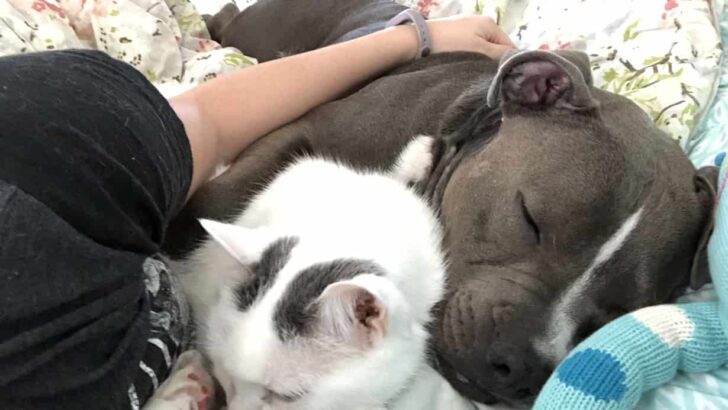- Nom Nom Dog Food Subscription Review - November 7, 2023
- 7 Best Dog Bed Ideas For Great Dane (DIY Options) - July 16, 2022
- Top 5 Rated Best Non-Prescription Diabetic Dog Food - July 15, 2022
Typically, we think of dog people and cat people as being at odds with each other– and of dogs and cats as being equally polarized. However, it doesn’t have to be that way. The same people who love dogs can also love cats–and dogs and cats can even love each other if we humans go about introducing them to each other wisely. Keep in mind, however, that each dog and each cat is an individual, and the fact that your dog or cat has gotten along with other dogs or cats in the past does not necessarily mean they will get along with each other.
Regardless of the cat(s) and dog(s) you plan to introduce, there are things you can do to help increase the odds that your cats and dogs will live together peacefully. Keep in mind, these introductions can prove dangerous, particularly for the cat involved, so be sure to take your time and make safety– not speed– your top priority.
Before Coming Home
Before you bring a dog home to your cat, consider your cat’s personality, as well as that of any dog you might bring home. Has your cat been exposed to dogs in the past? How did it go? Has the dog been exposed to cats? What were the results? If your cat has a history of getting along well with dogs, and the dog you plan to bring home has a positive history with cats, there is a good chance your introductions will prove successful. However, if a dog has any history of aggression towards cats, he is probably not the wisest choice of companion for your feline friend.
A dog who loves to run and chase as means of play might not be a good fit for a cat who runs around a lot, and may consequently look to the dog like a toy to be pursued. A cat who is shy and fearful will also likely not do well with an energetic or playful dog. If, however, your cat is calm and easy-going, lethargic even, and thus unlikely to attract a dog’s attention as potential prey or a toy, he may do well with an exuberant, playful dog.
Keep in mind that a dog who plays rough will likely not prove a good match for senior cats or for kittens, whose frailty means they can become injured more easily. Instead, a calm dog would be best for kittens and senior cats.
If your cat is calm, he may pair well with an anxious dog, but an anxious cat will rarely pair well with an anxious dog.

Body Language
The first rule of thumb to keep in mind is that it is best to introduce your dog and your cat at home, as opposed to bringing your cat to the dog’s shelter, breeder, or current location.
In the beginning stages of your introductions, monitor both the cat and the dog’s body language in various situations. If your cat pins his ears to his head and swishes his tail, he is unhappy with the arrival of his new canine companion. If when your dog sees your cat, he stiffens as stares at it, whining or crying, he has become fixated on the cat as potential prey. The same is true if he appears to be stalking it. Neither is a good sign, as both could indicate the dog’s intent to chase and potentially attack the cat.
Only after both the dog and the cat’s body language indicates that they feel calm and secure enough, should you attempt actual introductions.

Initial Introductions
Keep in mind that your initial attempt at introducing your dog to your cat might not go well, but you can try different methods if necessary. Michael Blankenbecler and his wife Ashley Unger faced the task of introducing their rescue pit bull, Gryff to their three cats. “Gryff would chase the cats if he saw them. If our cats were scared, they would let him know and swat him,” Blankenbecler recalls of their initial attempt. It took the family several tries before their pack calmed down and all the animals fell into their places.
In addition to preparing yourself for multiple attempts, be sure to always have enough people to help. You should have at least one person for every animal involved. If you are introducing one dog and one cat, for example, we recommend you have two people–one to handle and monitor the dog, and another to monitor the cat.
For the first few days at least, keep the dog and the cat separated, alternating which one is confined and which one can roam freely and investigate the other. Observe both pets’ body language as described above during this time, and always confine and separate them if you are not home.
Never, ever force either animal to approach the other; instead, let them observe each other at their own comfort level and become acquainted at their own pace. Forced introductions can induce anxiety, and rarely succeed. Blankenbecler recalls his concerns “that Gryff would be too rough and playful with the cats,” and explains that to help the cats adjust, “we just allowed the cats to keep their distance. Gryff was always around us, mostly downstairs, and the cats would come see him when he would be resting or calm. They tried to stay away when Ellie, our other dog, and Gryff would play.” Unger continues to explain that “Ellie and Gryff were immediately soulmates and loved each other, and with that came a lot of playing. When the dogs would calm down, the cats would come out, wide eyed, and slowly approach the new addition to the family. This went on for a few weeks before we saw the cats come out during dog playtime. Now the cats stand on their own when the dogs are doing anything rambunctious.” In part because the couple allowed their cats to adjust to their new dog on their own terms, their cats and dogs harmoniously coexist.
Regalo Deluxe Easy Step Extra Tall Gate, Platinum
No products found.

Gradual Desensitization
One of the best methods to try if your dog seems to view your cat as prey is gradual desensitization. Keep your cat in a room the dog does not have or need access to, and where your cat will be comfortable. Be sure to outfit the room with all your cat’s needs (water, food, litter box, toys, etc.), and don’t forget to visit him often!
On certain occasions, after making sure neither your cat nor dog can breach the barrier between their spaces, set up a doggy gate so they can see each other, but not access each other. Keep your dog leashed and allow him to view your cat for short intervals, praising him for calm behavior and redirecting his prey drive if needed. Training treats like the one shown below can help.
Zuke’s Mini Naturals Chicken Recipe Dog Treats – 16 oz. Pouch
No products found.
At meal times, close the door and feed your dog and cat right next to each other, on either side of the closed door, so they get used to smelling and hearing each other. Some experts also recommend swapping out their bedding to get them accustomed to each other’s scent.
The desensitization process could take a few hours–or several months, and in some cases, it may never work. Blankenbecler concluded it was safe for his new dog and his cats to be in the same space together “when the cats no longer ran from Gryff, or when Gryff stopped thinking they were toys and understood they were animals like him.”
If it becomes clear you will not be able to trust your dog and cat around each other, prioritize safety and keep them separated at all times.
Regalo Deluxe Easy Step Extra Tall Gate, Black
No products found.
Face to Face
Face-to-face introductions can work if your dog has not exhibited prey drive. To execute face-to-face introductions, keep your dog on a leash and watch his body language while someone else watches cat’s body language. If both seem calm, allow your dog to sit or lie down on his leash and allow your cat to roam around him/her, investigating. Continue this process for a few minutes, days, or weeks–until you are confident that neither animal poses a threat to the other.

Training Plans
If neither of the above methods seem to be working for your pack, try Look at That (LAT) training, which teaches your dog that ignoring your cat is rewarding. Clicker training can prove another effective method.
EcoCity 2018 NEW UPGRADE version Dog Training Clicker with Wrist Strap – Pet Training Clicker Set (4 Pack)
No products found.
Red Flags
While most cats and dogs will eventually grow used to each other and can even form strong bonds, there are some who will simply not get along. If over several weeks and after many attempts, any of the warning signs listed below still occur, we advise you to keep your dog and cat separated indefinitely, understanding that the relationship will likely not be a safe one. Red flags include:
- The dog is still fixated on and exhibiting prey drive toward the cat.
- The dog lunges at the cat even when it is still.
- The dog growls at, barks at, or otherwise behaves aggressively toward the cat, even if it is still.
- The dog lunges at the cat if it moves suddenly.
- The cat attacks the calm, quiet, uninterested dog.
- Without true provocation, the cat regularly hisses or swats at the dog.
- The cat stops eating, drinking, playing, socializing with family, or using the litter box.

The Best of Both Worlds
You don’t have to choose to be a dog person or a cat person; you can be both, as Blankenbecler and Unger have learned. Blankenbecler loves being the dad to both dogs and cats, and getting to witness “the different connection and relationship that each animal has with each other. No two animals’ bonds are the same.” Unger describes the “major sense of accomplishment” she feels at having “a boxer-lab and a pit bull love not only humans and each other so much, but also be so sweet to our cats. Gryff lets Oliver, one of our cats, lick and clean his face. Gryff cleans Ellie, our other cat, often. The dynamic is beautiful and we are so proud to have so much love in our house among the humans and the animals alike.”
Blankenbecler and Unger’s pet parent advice?
“If you have a cat that hides all the time, adding a dog may cause too much stress. If you get a young dog to bond with a young cat, they seem to grow up together which helps them build a relationship,” Blankenbecler explains. Unger adds that “introducing them as kittens and puppies has worked wonders. They’re vulnerable and kind and it’s almost as if their nature is to simply love each other.”
Want all the best resources for cat parents? Visit our sister site, OliveKnows.com
Helpful Resources
Continue reading:
Odd Couples: How Dogs Bond With Other Animals
Angry Orange vs Nature’s Miracle
Dog-Proof Litter Boxes: What to Know, What to Do, and What to Buy




